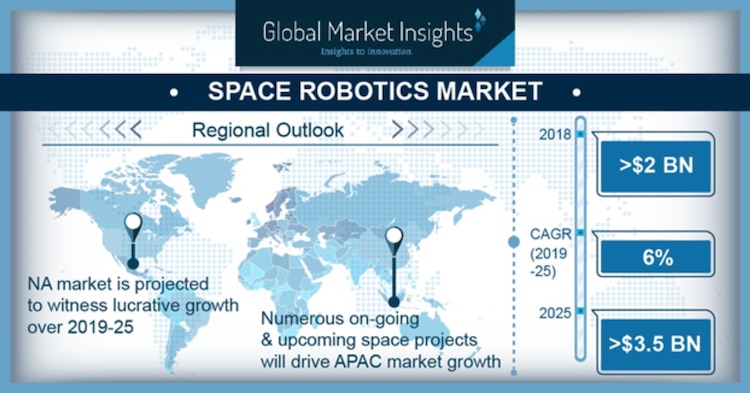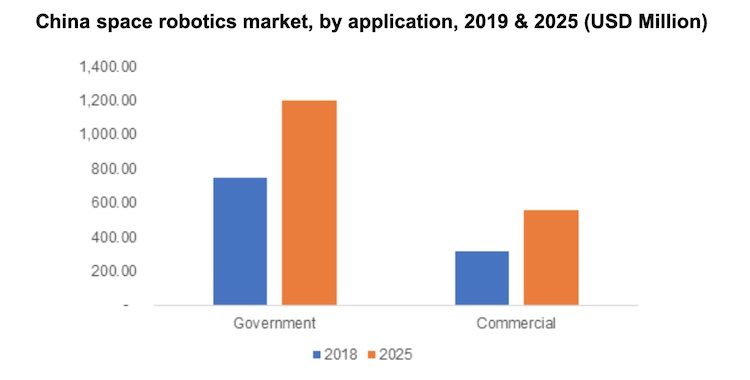Space robotics market to boldly go beyond $3 billion by 2025
The global space robotics market is set to grow from its current market value of more than $2 billion to over $3.5 billion by 2025, according to a new research report by Global Market Insights.
In the space robotics market, near space exploration & transportation segments are gaining popularity due to several missions working on asteroid survey missions, which are near to the Earth’s surface.
The need for continuous maintenance & servicing of the existing satellites is creating a huge demand for this segment, adding up to the market growth.
The near space transportation segment utilizes advanced transportation systems that support transporting of heavy cargos to the existing objects for repairing and other purposes.
Various companies are gaining huge investments to carry out their near space transportation projects.

For instance, in May 2018, zero 2 Infinity, a near space transportation company announced that it has gained an investment of $1.3 million from Crowdcube in support of its space accessibility project.
Commercial applications in the space robotics market are growing due to technical advancements and various exploration missions adopted by governments along with companies.
In March 2019, SpaceX announced the launch of Crew Dragon’s demonstration mission, which was intended for demonstrating the company’s capabilities including safety of astronauts to fly to and from the International Space Station.
The spacecraft is America’s first one to autonomously dock along with the orbiting laboratory.

The segment includes companies that include satellite operators and private owners, launching service providers, and exploration companies, which aid in the proper functioning of spaceflights, adding up to the market growth.
The space robotics market is experiencing a rapid technical development owing to the integration of AI technologies into the systems developed for space exploration.
Several companies are developing AI-based robots that provide enhanced mobility and manipulation benefits.
These machines can perform highly-complex tasks for a longer duration and offer minimal human dependence.
The integration of AI offer 3D perception and proximity GNC to robots, which will support resistance against environmental conditions and offer high flexibility, accuracy, and control.
In November 2018, an AI-based robot, CIMON started its first conversation with the spacefaring crew.
The robot is designed by DLR Germany in collaboration with IAM and Airbus.
Moreover, the increasing experiments & projects related to space exploration by government agencies globally are attributing to the market demand.
North America is a leading participant in the market owing to the presence of national organizations, including NASA and CSA, that are actively working toward the industry development.
The US and Canada are investing huge amounts in R&D and technology enhancement to achieve space exploration initiatives.
The Asia Pacific space robotics market is also growing at a rapid pace in countries including India, Japan and China due to several on-going and upcoming space projects.
In September 2018, Japan Aerospace Exploration Agency announced that its two rovers had successfully landed on an asteroid named Ryugu and started a survey on its surface.
These robots are efficiently working in the low gravity environment, allowing them to gain knowledge on Ryugu’s physical aspects.
China space robotics market, by application, 2019 & 2025 (USD Million)
The key companies operating in the space robotics market include Oceaneering International, Maxar Technologies, Northrop Grumman, Astrobotic Technologies, Motiv Space Systems, Altius Space Machines, and so on.
These players are investing heavily on R&D activities to develop new solutions related to exploration and transportation in both deep & near spaces.
Strategies such as partnerships and contracts, with other companies and government organizations including NASA, ISRO and so on, are strengthening their position in the market.
In November 2018, Northrop Grumman announced that its Cygnus spacecraft completed berthing operations with the ISS. The spacecraft carried about 7,400 pounds of supplies, cargos, and other scientific experiments.

